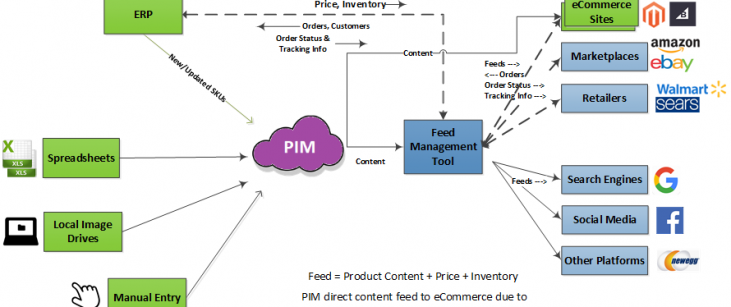


Most Americans shop online. A majority of these online customers start their product search on search engines, market places, and retailer websites. Visibility and discovery are two of the most critical elements when it comes to competing for mindshare of potential customers online, hence companies must make the necessary investments in modern technology to ensure great product content is continuously fed to the right sales and marketing channels, at the right time. Effective product feed management involves providing complete, accurate, and timely product data that meets the individual requirements of various channels. Channel-specific data requirements keep evolving, companies continue to adopt more channels to sell through, and enterprise product data is constantly in a state of flux (i.e. new products are introduced, current ones are updated or obsoleted). Legacy operations typically used to manage product feeds involve high cost and complexity and often slow down a company’s ability to provide relevant product feeds to sales channels. Specialized product feed management tools and service providers play a key role here helping companies overcome many of those challenges resulting in a shorter path to purchase – leading to more conversions. It is also a best-practice for digital winners to leverage a modern Product Information Management (PIM) tool that helps them master and share product data efficiently with employees across the company and with feed management tools and other consumers of product data.
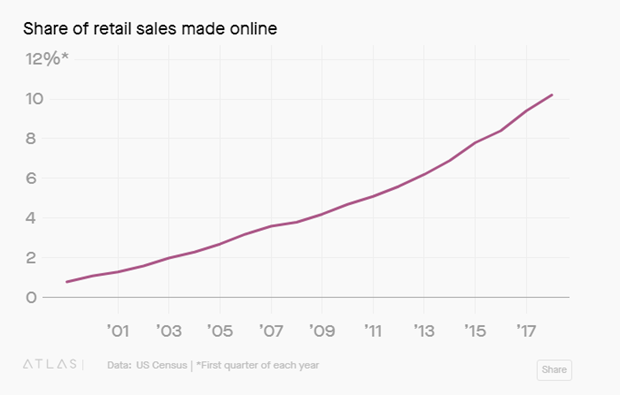


In this whitepaper, we discuss in detail the importance of optimized product feeds, outline common product feed management issues and review how a product feed management tool like Feedonomics helps overcome these challenges. We also review key features of a Product Information Management (PIM) tool that helps create consistently high-quality product data at scale so it can be shared with sales and marketing channels. Finally, we propose a reference solution architecture that combines PIM and Feed Management tools to maximize content and feed management related task automations as well as orchestrate multi-channel order management.
The Importance of Optimized Product Feeds
Product data feeds are an essential part of eCommerce. It is the method in which your data is sent to shopping channels and marketplaces where you want your products listed and found easily by consumers when they need it. The figure below illustrates just how many consumers look up product data on their devices even when they’re shopping in a store.
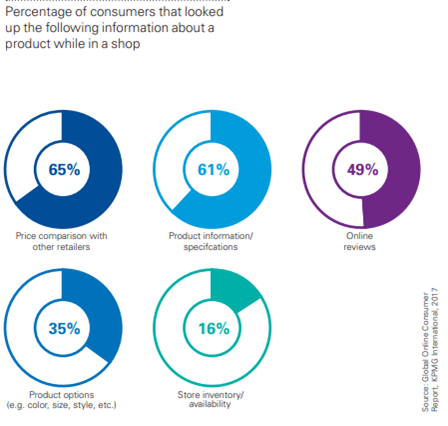


There are many crucial elements that make up a successful shopping feed. If you have 20 total products, you could of course optimize your products one by one manually, but what if you have thousands or millions of products? Therefore, a comprehensive feed management platform is the only way to truly manage and scale up your eCommerce campaigns.
Optimizing your product feeds is a critical part of succeeding on Amazon, Google Shopping, Walmart or on an auction site like eBay. Why? At the highest level, search algorithms often match the keywords users type into their search against your product attributes, giving extra weight to your title, category and description. Product feed optimization is key to a higher CTR, raising the average order value, increasing attachment rates, and ultimately getting the best performance out of your campaign.
The recipe for online product listing success:
- An optimized feed – You want to ensure your online ads stand out with clear understandable wording that ticks all the boxes based on what the person shopping is searching for. Your ad copy must contain attributes that paint a picture of what they will be purchasing, such as color, size, material, gender, price, brand, and more.
- SEO friendly – Whether it’s Google, Amazon, Facebook, Walmart, or eBay, all these large online shopping platforms want to give their shoppers the best possible user experience. An optimized product feed often comes with huge rewards for the advertiser such as higher impression share, a lower cost per click, and a higher conversion rate.
- A healthy account – If you have ever encountered a Google Merchant Center disapproval or error, you will understand the frustration this can cause. Every online marketplace adheres to a strict set of rules. Amazon uses Order Defect Rate (ODR) to measure a seller’s ability to provide a good customer experience. Of course, Amazon sellers will want to avoid receiving a high ODR, which could lead to a suspension or even termination. Being able to flag, diagnose, and resolve errors quickly helps maintain a consistent revenue flow. Example – Having an account suspended over Black Friday weekend could be catastrophic for your company.
Responsive Shopping Campaigns
An ad campaign will suffer if you do not have an optimized product feed. A product feed is the cornerstone of any successful campaign. Without proper feed optimization, it’s unlikely your products will show up at all, and if they do show up, it’s often at the expense of very high bids, because your products are not seen to be as relevant.
Best Practices:
- When you structure your product attributes similarly to the words and phrases that users are looking for on different platforms, it increases your ad’s relevancy.
- Product title, description, and categorization are critical here. You’ll want to ensure that your product titles contain attributes like brand, name, size, and color so that your item surfaces in product searches.
- Provide high-resolution images and make sure to use the optimal height and width for the platform where you’re advertising. A white background to make your images pop is best.
- For some products, you’ll want to provide additional images of the item from a different angle to capture special details.
- Ensure the product specs associated with the item are described accurately and thoroughly.
- Categorization is key. For example, Walmart assigns products to specific categories, and within each category, there are sub-categories. Also, attributes for products are required. Make sure that product categories, sub-categories, and required attributes are set up correctly so there are no errors or unpublishing issues. Customers who browse or use filters when shopping won’t be able to find your products if you’ve miscategorized them.
Better Return on Ad Spend (ROAS)
An optimized feed allows you to enhance the core component of a Shopping campaign, which is relevancy. A relevant campaign needs to meet or exceed the associated platform’s algorithm. This will influence the amount of impressions share one advertiser will receive over another, as well as the cost per click and more importantly, the number of clicks the ad will receive.
With regards to Google Shopping, if your campaign “pleases” the Google algorithm, it can lead to:
- Higher impressions share
- Increased click-through-rate (CTR)
- Lower costs
Similar to Google Shopping, pleasing the algorithm on marketplaces such as Amazon, Walmart, and eBay require the following considerations to get the most out of your marketplace SEO:
- Better product data for relevancy
- Competitive price point
- Product availability
- Quick turnaround on order fulfillment
- Low or free shipping
- Customer reviews
Combining your traditional PPC optimizations with marketplace best practices, should give you the edge against your competitors.
Faster order management and fulfillment can help with the above best practices situations. How so? Product prices are updated constantly, new products will be added in, and old or seasonal products are discontinued. If you don’t revise your product feed, then you are at risk of receiving feed errors or disapprovals.
Common Product Feed Issues
Some common product feed issues include:
- Duplicate titles
- Titles with missing information
- Whitespace issues
- Rogue HTML
- Not listing full catalog (e.g. only top sellers listed)
- Missing alternate image angles/views
- Poor image quality (resolution, size, etc.)
- No associated products
When your product data is clean and optimized, there are no rogue HTML or missing values, and it is correctly mapped to the specifications of each channel.
The following is a list of common Google Merchant Center errors:
- Automatic item disapprovals due to policy violation (e.g. “Dangerous Products” policy violation where a site sells guns, gun parts, and explosives)
- Product pages cannot be accessed
- Missing images
- Invalid price data
- Incorrect product identifiers
- Missing GTIN
- Missing shipping information
- Temporary item disapprovals due to incorrect availability
- Missing required attribute: color
- Missing required attribute: size
- Multiple sizes for one item
- Incorrect shipping costs
- and so on…
Unresolved Google Merchant Center (GMC) errors and disapprovals can result in thousands of dollars of lost revenue per day. For a company that lists and sells hundreds or thousands of items, it is a daunting amount of work to monitor product listing errors and warnings on those channels on a daily basis. Furthermore, those errors due to bad data on Amazon could result in a delisting of products, fine or even suspension. Updating price, inventory, and other content for those items routinely also requires a significant amount of work. Another big challenge is the task of orchestrating orders coming in from multiple sales channels. Companies often struggle with timely entry of channel specific orders into internal systems (online store or ERP or OMS) and timely update of order status on various sales channels – these operations are typically manual and error-prone.
Even if product feeds are optimized, there are other data challenges that companies routinely deal with:
- Incorrect data: For example, wrong price, availability, or dimensional data. These will contribute to wrong product shipments, excessive returns, customer dissatisfaction, and lower profits. Other issues include poor image quality, insufficient number of product images, etc.
- Delayed product introductions: It’s not uncommon for companies to list only a subset of their catalog online due to data availability and setup issues. For example, inability to launch new products or promotions in time for a Black Friday leads to lost sales.
- Inconsistent data across channels: Customer expect omni-channel consistency and will avoid or punish companies that don’t deliver it.
- Inconsistent data across brands or categories: In the same company, titles and descriptions across brands and/or categories are often constructed differently. The availability of commonly searched product specifications and digital assets also varies widely across product categories. This makes it harder for customers to find and purchase products online.
A lack of visibility into these data issues and control over what data gets distributed to specific channels is a common issue. These challenges result in a variety of problems including lost sales, stockouts due to poor inventory and availability management, and costly operations.
Feed Management Tool to Tame Cost and Complexity
A product feed management tool like Feedonomics can address many of these problems. The tool streamlines the creation and management of optimized product feeds to help save time and money. It will also sync the latest price and availability data with all channels on a timely basis. With Feedonomics’ proprietary tool (FeedAlerts™), you can receive notifications for Google Merchant Center errors and warnings daily. Feedonomics can also help with automated order management. The platform will automatically pull orders from each marketplace channel and deliver them to your system in one dashboard. Everything is synced to your online store (or another system like ERP or OMS) so that you can efficiently manage Marketplace inventory. This will prevent oversold situations and ensure that product availability is accurate.
Many companies don’t have a centralized repository of product data. So, preparing product feeds, including via getting the data from your website, can be tricky. Feedonomics can pull product data from any feed file, shopping platform, product content platform, or custom site with any kind of schedule. It is a low-cost way to ensure your products are at the “eye-level” on the digital shelf.
- Data Ingestion: We can pull data into our system in nearly any format – SFTP, FTP, URL, JSON, Google Sheet, or custom API if needed.
- Data Joins and Mapping: We can join any dataset together with a common key (i.e., ‘product_id’). This allows us to merge data from disparate systems, like inventory, margin, or performance data, into the main catalog. We can then map these datasets to any field required by a channel. For example, we can create rules in the feed to map product categories that map to channel specific product categories.
FeedTelligence
FeedTelligence™ is a powerful keyword recommendation tool. It will automatically compare your Google Shopping feed to actual converted search terms and allows you to see missing words for title and description optimization on a per-SKU basis.



FeedAlerts™
FeedAlerts™ is an easy way to receive notifications for both Amazon and Google Merchant Center (GMC) errors and warnings. Unresolved Amazon or GMC errors and disapprovals can result in thousands of dollars of lost revenue per day.
Feedonomics can set up FeedAlerts™ to:
- Monitor import/export errors
- Automatically check your Google, Amazon, and other accounts twice a day
- Set thresholds on an overall and individual error basis
- Send a notification when you exceed an error threshold
FeedAlerts™ is a game-changing tool that will save your company time and money – fewer errors will result in more active products and higher sales.
You’ll receive an email with a detailed report listing the errors with links. If the errors are feed-based, Feedonomics’ 24/7 support team will fix them.
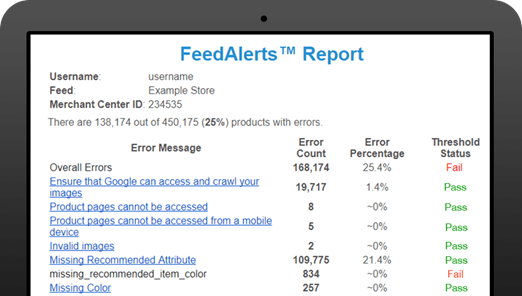


“Feed Optimization and Order Management helped a retail client achieve a 260% increase in revenue on Amazon and a 290% increase in revenue on eBay.” – Feedonomics
PIM, For High Quality & Consistent Product Feeds
As discussed earlier, poor quality product data is a huge problem in the digital world. Data inconsistencies across channels makes the bad data problem worse. Disparate legacy systems and spreadsheets typically used to manage product data leads to a variety of product data management challenges. Centralizing product data in a PIM system can help feed clean and complete data to sales channels. A modern PIM provides the necessary data visibility, control, and scalability to create great product feeds that can be leveraged by multi-channel shopping campaigns to deliver a better ROAS.
A PIM (Product Information Management) is an enterprise data management solution that:
- Centralizes product data required to support commerce operations
- Simplifies generation of compelling, consistent, and high-quality product data
- Synchronizes product data with internal systems, marketing and sales platforms, customers, and partners
- Scales up data acquisition, enrichment, and publishing efforts
Noted below are some key benefits of a PIM solution:
Single source of trusted data: PIM creates a single source of trusted product data by aggregating it from multiple sources, and by cleansing, enriching, governing, and maintaining it consistently.
High-quality and consistent data: Product and variants management, data inheritance, data validations, quality checks, completeness checks, bulk edit features, rules-based auto-enrichment, approval workflows, and role-based permissions ensure you create and deliver consistently high-quality data.
Integrated digital assets: PIM helps you onboard, link, control, and share product assets with digital channels. PIM simplifies the task of associating imagery, videos, PDFs, and other digital assets with product data.
Support for product feed management: Great product feeds to search, social media, and retailer websites will ensure customers find and purchase your products. PIM holds high-quality and SEO friendly data that can then be fed easily to product feed management tools to help drive traffic and sales from multiple digital channels.
eCommerce accelerators: Manage rich product data systematically to enables navigation and exploration features critical for conversion on eCommerce sites. These features include intuitive categories and sub-categories, helpful product names, facet navigation, cross-sell compatible products, comparison, etc.
Business agility: By integrating PIM with other enterprise systems, trusted product data can also be shared efficiently with internal analytical and operational systems, thus reducing manual and redundant efforts. This will also make the enterprise more agile and responsive when it comes to implementing new digital initiatives (for e.g., launching a mobile app).
Reference Architecture for Agile Feed Management and Order Orchestration
Product feed management combines the creation of product feeds, optimizing feeds to meet channel specific requirements, syndicating feeds to multiple channels, and reporting and recovering from feed listing errors with the key goals of maximizing online leads and sales. Additional scenarios include automatically managing inventory levels across channels, aggregating orders and inputting them into an internal order management system for processing, and sending out order statuses to various digital sales platforms.
A best-practice reference solution architecture combines the power of a PIM and a feed management tool for optimal product feed management and multi-channel order orchestration tasks. Although an eCommerce platform is a convenient option to provide product feeds to a feed management tool, it is not the best option. Often times, data in an eCommerce site is wrong, incomplete, or dated. Add to that the fact that not all products may be listed on the eCommerce site for technical or data quality related issues. An eCommerce tool (and an ERP system too) is not suitable for proper data management and this means that product data issues are not fixed in a timely manner. A PIM is the right tool for product data management, and hence an integration between the PIM and a product feed management tool like Feedonomics is a better solution architecture for digital success.
Listed below is a proposed reference solution architecture for efficient product feed management and order orchestration.
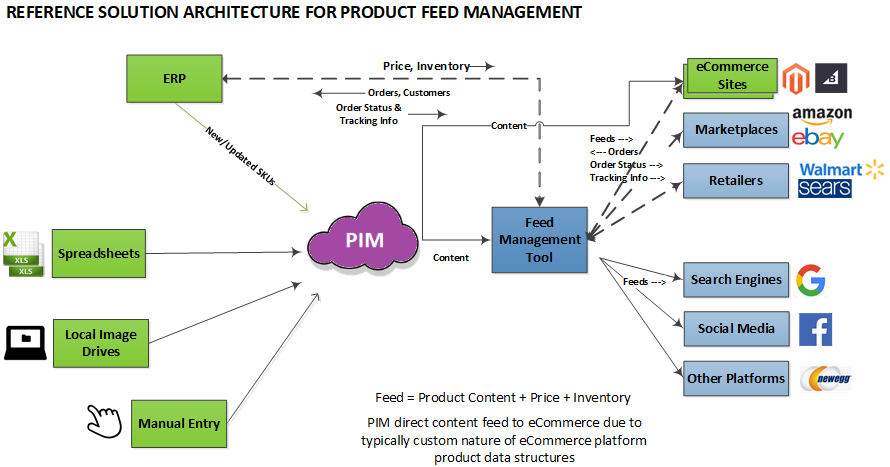


This integrated solution provides many benefits:
- delivers high-quality product feeds consistently to multiple sales channels
- feeds latest price and inventory data sourced from ERP or other system
- speeds up creation of product feeds that contain correct, complete, and SEO friendly data (via completeness, content automation, bulk edit, workflow, and other features)
- provides product data intelligence (e.g. keyword suggestions, listing errors, catalog level analytics) and alerts to maximize active product listings, findability, sales, and ROAS
- automates various manual tasks typically associated with multi-channel order management
- provides greater visibility, control, and agility over product feeds, orders, and channel analytics
“Retailers need to be more aware and responsive than ever to when and where their potential customers are making decisions throughout their ‘always on’ shopping journey.”- KPMG
Every industry is getting disrupted, and eCommerce is here to stay. Digital winners are using technology and integration to improve their core business and break into new markets and new customers. They’re streamlining user journeys, telling better product stories, optimizing for mobile ecommerce, personalizing customer relationships, getting products to market faster, and driving operating efficiencies across business support functions. Are you going to be a digital winner?
Contact Us
The Feedonomics and StrikeTru teams have a track record of successfully implementing Product Feed Management and PIM solutions across industry verticals. For more information or to discuss how we can help, please contact Brian Roizen at [email protected] or Vik Gundoju at [email protected].







